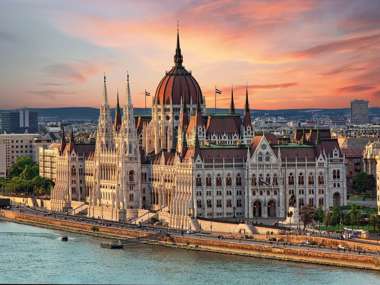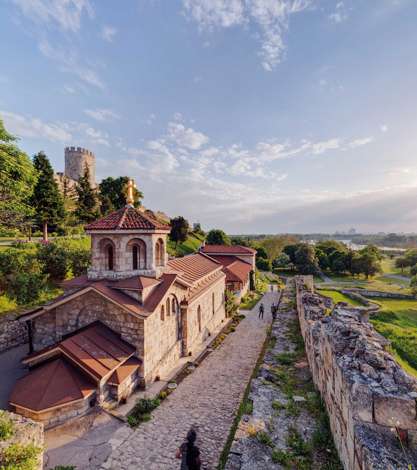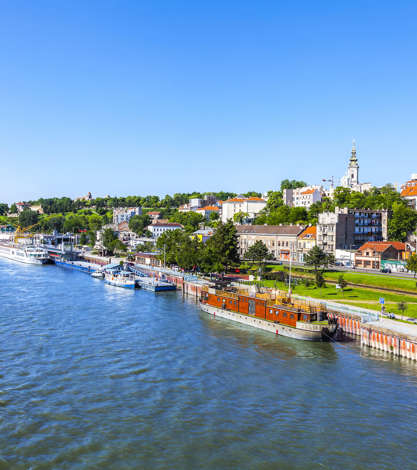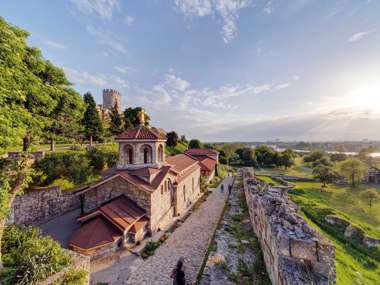Escorted Tours to Serbia
From its ski slopes, Danube islands and sylvan landscapes, to the malls, museums, massive cathedral and countless clubs and cafés in the capital; and from a long historic heritage to forward-looking enthusiasm, Serbia does nothing by halves.
Why choose a tour in Serbia?
A journey through Serbia is a tour through two thousand years, from Roman ruins to Celtic culture, castles and cathedrals; via landmarks and legends of turbulent times in ancient, medieval and recent history.
In the capital, Belgrade, at the confluence of the rivers Sava and Danube, the mix of monuments and eras ranges from a medieval castle to Tito’s tomb; Soviet-style severity contrasts with grand façades hemming Republic Square; and St. Sava Cathedral, the biggest church in the Balkans, tops the bill with 49 bells and 18 gold-plated crosses crowning its spires and domes.
Novi Sad is Serbia’s second city and cultural heart, with the Petrovaradin Fortress set on a bluff above the Danube, the Gothic architecture of its Stari Grad old town on the opposite riverbank, and the 16th-century Krusedol Monastery, Novi Sad’s spiritual beacon, on the slopes of Fruska Gora mountain.
Less-visited Nis is one of the oldest cities in the Balkans, steeped in ancient history and Celtic legend, teaming cobbled streets with Bohemian character, and dominated by the daunting 18th-century fortress, an Ottoman enclave, set by the river and encircling an ancient citadel within its sturdy walls.
In the Baroque town of Sremski Karlovci, it’s said that every street has its own historic story. Dubbed as a place of ‘wine, culture and creeds’, its focal point is photogenic Branko Radicevic square, where the Patriarchal Palace, Orthodox St. Nicholas Cathedral, and Catholic Holy Trinity Church are among majestic monuments.
Viminacium is a window on the ancient world. A major city from the 1st to 4th centuries AD, it is now an amazing archaeological site, revealing the Roman relics of baths and temples, the pantheon and theatre, an aqueduct, and the Emperor Hostelian’s tomb.
Jules Verne’s journeys in Serbia are teamed with Bulgaria and Romania on a land-based tour, and form part of our Danube cruise from the Black Sea to Bucharest.
When to go on Serbia holidays
Despite its compact size, Serbia’s climate does vary from the north, around Belgrade, to the central southern region. In general, winters are cold to freezing; spring is unpredictable and can bounce from balmy to cold and snowy; and in summer and early autumn, nights are cool (around 15°) and daytime temperatures range between 23 and 29°.
Jules Verne’s journeys run between May and September, the most comfortable months for touring.
Who are Serbia tours suited to?
Small enough to explore in relatively short journeys, Serbia will inspire the curious traveller with its history, cultural sites, characterful towns, and contemporary tempo, and with its beautiful scenery.
Jules Verne’s journeys offer a personal experience, in sociably small groups of like-minded people.
Why book Serbia tours with Jules Verne?
With 45 years’ experience and a passion for creating extraordinary adventures, Jules Verne takes you to iconic landmarks and lesser-known sites, with expert tour guides who share their local knowledge, and show you hidden gems.
Our guided tours to Serbia are ABTA and ATOL protected, so you can book with complete confidence.
The Balkans Revealed
Covering three countries’ capitals and a kaleidoscope of colours and cultures, this bountiful tour of the Balkans crosses borders and beautiful landscapes, to reveal the ancient sites, artistic treasures, and medieval monuments of Bulgaria, Serbia, and Romania

Secret Danube
Sailing from the Black Sea to Budapest, this is a fascinating and multi-faceted journey, revealing the less-known reaches of the Danube, and cruising through the ravishing riverscapes which connect the countries, capitals, and cultures along its remarkable route




